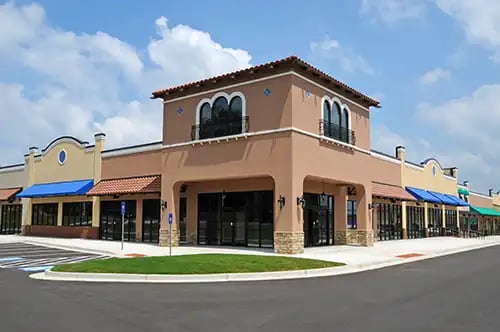
Designing commercial projects is a highly collaborative process that is guided by the specific needs of clients and the site. Commercial projects soften let form follow function to the extreme, and the end result can often border on the utilitarian. This is the nature of commercial design, but the most successful firms have developed strategies over time that create space for uniquely creative touches within a highly functional framework.
Although the building might offer limited scope for "artistic freedom," fixtures present an excellent opportunity to introduce some flair. Awnings, specifically, can subtly elevate the visual appeal of projects. Architecture firms can infuse typically ordinary commercial projects with a touch of style by incorporating awnings.
Function And Commercial Considerations Can Restrict Design
Countless factors influence a building's design—everything from zoning regulations to the confines of the space will define the finished product. The function of the building can also restrict the design. From factories to offices to airplane hangers, the client needs the structure to accommodate a specific space or function most economically. This can prevent architects from exploring innovative design techniques or incorporating new creative aspects in the building's design.
Interior spaces are often the most influenced by functional needs. An open-floor office plan or a large factory floor usually requires architects to cede control to engineers who must determine ways to make these spatial needs a reality. Similarly, working with established businesses on commercial projects can amount to accommodating previous design templates to a new space. Retail businesses, in particular, often want a degree of uniformity between locations. Yet, in all of these cases, exterior spaces provide an opportunity for architects to flex their aesthetic sensibilities during the design process.
Exterior Fixtures Like Awnings Provide a Creative Opportunity
Fabric awnings can be a great way to influence the look of the building’s exterior, to take a more traditional design and add a functional fixture that enhances its aesthetics. When added to austere commercial exteriors, awnings can often serve as a visual calling card, combining functionality and aesthetics. The choice of material is directly related to how well it performs and how long it lasts. At the same time, the fabric color is an essential element in finalizing the appearance of the building’s façade. Herculite produces high-quality awning fabrics in various styles and colors, to help create a customized look for the exterior of commercial buildings.
Awnings can also be valuable in creating community spaces outside buildings, allowing workers to congregate and get fresh air while being shielded from the sun and other elements. Extending the awning into a fabric canopy can also serve many additional purposes, from covering a seasonal outdoor patio or work area to protecting from the elements for consumers or workers entering or leaving the building. Awnings and canopies can help to subtly alter the character of the building to shift it from a simply utilitarian design to one with more character. In shaping these solutions, it’s essential to consider what elements of awning fabric affect their quality. Herculite’s fabrics have superior stability and the flexibility needed to shape awnings or canopies for almost any project.
A Creative Embellishment with Clear Functional Benefits
A key advantage of using awnings as a design feature is their ability to provide both aesthetic enhancement and practical cost-saving benefits. This dual purpose makes them more appealing to clients. They offer a chance to enhance a building's visual appeal while delivering tangible long-term advantages.
Awnings shield against the sun and can shade windows from harsh sun angles that may increase indoor temperatures. Well-positioned awnings can result in substantial energy cost savings.
Through its color and shape and how it integrates with the building's overall design, the awning can reflect the client's brand identity or business personality. Graphics can also be incorporated. In commercial districts, this can guide clients or consumers. The appearance of the awning can attract customers to retail businesses. A carefully selected color can catch the eye in ways that a conventional building design might not. Ultimately, an awning enhances curb appeal while providing a unique look.
Commercial project awning fabrics allow these exterior fixtures to become part of a building’s aesthetics. Architects can use them to enhance a building’s overall look, transforming a functional commercial project into something that attracts greater attention.